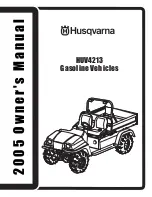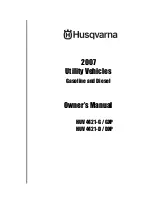
Page 12
dIsAsseMbly ANd AsseMbly
1. The brake tongue is assembled and adjusted at the factory:
Do Not Disassemble or Attempt to Adjust
The Tongue Push-Rod Assembly (#11)
To disassemble the tongue: (refer to illustration on page 15)
A. Remove 3/4”bolts (#8) , remove stop block (#7), and pull
male tongue (#30) out of female tongue (#1).
B. Remove 1/2”bolt (#4), pin (#25), and spacer (#27)
C. Remove set screw (#24) from adjustment spud (#23b),
unthread and remove adjustment spud (#23b).
D. Remove push-off assembly (#28), pin (#29), two shocks
(#26), and two springs (#10).
E. To remove tongue push-rod assembly (#11), master
cylinder (#2), emergency lever (#14), pin (#15), spring
(#16), and guide (#17), refer to section a&b of “Servicing
the Emergency Lever” on this page.
To reassemble the tongue: (refer to illustration on page 15)
A. Replace 2 shocks (#26) into yoke (#28), with pin (29).
B. Place 2 springs (#10), onto shaft of push-off assembly
(#28), and insert shaft into female tongue (#1), through
hole in plate (shown in exploded view).
C. Thread adjustment spud (#23b) onto rear threaded
portion of push-rod assembly (#28), until the 2 springs
(#10) compress to a length of 6-1/2”. Install and tighten
set screw (#24), using Locktite, into one of the threaded
holes of the spud (23b).
D. Insert pin (#25) into hole in tongue, through 1 shock (#26),
through the spacer (#27), and through the other shock
(#26) and tongue. Install and tighten 1/2” bolt, lockwasher,
and washer (# 4,5,6).
E. Install master cylinder (#2), (refer to c-f of “Servicing
Emergency Lever” section on this page).
F. Thread adjust spud (23a) onto front threaded portion of
push-rod assembly (#28). Insert male tongue (#30),
(with latch installed as shown), into female tongue (#1).
Install stop block (#7), using 3/4” bolts and lockwashers
(#8, #9). Pull male tongue (#30) forward to latched
position and adjust spud (#23a) until there is a 3/16” gap
for 650/750 and 7/16” gap for 550 between spud (#23a) and
rear stop surface of male tongue (#30) see arrow.
G. Tighten set screw (#24),using Locktite, into hole in spud
(#23a).
2. Connect and tighten all brake lines.
3. Fill the Master Cylinder (#2) with DOT 3 or 4 brake fluid.
4. Bleed the brake system using a pressure-type brake
bleeder or manually, as follows:
a. Remove the two Self-Tapping Screws (#18) and
LockWashers (#19) that hold the Lever Guide (#17)
and the flat Emergency Lever Spring (#16). Remove
the Lever Guide and the Emergency Lever Spring.
Using short strokes, pull forward on the Emergency
Lever (#14), pumping the Master Cylinder until
the brake fluid within the Master Cylinder stops bubbling.
b. Attach a bleeder hose to the bleeder valve on one of
deMco bRAKe ToNGue MAINTeNANce ANd AdjusTMeNT
Review all of the following instructions before installation and use of the hydraulic brake tongue.
dealers or distributors must review these instructions with the ultimate user. failure to follow these instructions,
or failure to properly maintain the braking system after installation, can result in loss of braking action which could
cause severe property damage, personal injury and/or death.
the wheels (always begin with wheel farthest from the master cylinder
and move toward it). Immerse the other end of the hose into a
clean, transparent container partially filled with brake fluid. Loosen
the bleeder valve one turn and, watching the hose in the transparent
container, use the Emergency Lever to pump the Master Cylinder
as long as air bubbles continue to leave the hose. When the bubbles
stop, close the bleeder valve, move to the next wheel, and repeat
the process until all the brakes have been bled. (Note: Check the
fluid level in the Master Cylinder frequently while bleeding the brakes
(every 4 or 5 strokes). Refill as necessary to keep the level above
half full.)
5. Once bleeding is completed, refill the Master Cylinder and attach
the Cap (#20) securely. Replace Emergency Lever Spring, Lever
Guide, with Lock Washers and Self-Tapping Screws.
6. Test the brakes by pulling the Emergency Lever (#14) forward until it
locks into its first detent position. (The lever should be approximately
straight up.) Attempt to rotate the wheels in a forward direction.
If any of the wheels rotate, the brakes must be adjusted on that
wheel. To adjust the brakes, release the Emergency Lever from
its locked position and set the wheel brake adjustment up 2 or 3
notches (refer to instructions on page 16). Repeat the test procedure
as necessary.
MAINTeNANce
1. Frequently check the brake fluid level. (Fluid must be approved,
clean and uncontaminated.)
2. Inspect the brake tongue and brakes and replace bent, worn or
damaged parts.
3. Be constantly aware of the system’s braking quality and make periodic
checks. Consult a certified brake specialist to make the necessary
adjustments and/or repairs. Failure to do so could result in loss of
braking.
seRvIcING The eMeRGeNcy leveR
If the Emergency Lever (#14) of the tongue is applied, it can be disengaged
by using a screwdriver to lift upward on the front of the flat Emergency
Lever Spring (#16) while pulling the lever forward until it releases. A
thorough inspection of the Emergency Lever, Emergency Lever Spring,
and the Chain with S-Hooks is required and all damaged parts must
be replaced as follows:
a. Remove the Master Cylinder (#2) and the Push Plate Assembly
(#11). Be careful not to get dirt into the Master Cylinder. (A new
Master Cylinder Gasket (#3) should be used when reinstalling.)
b. Remove the Safety Chain from the Emergency Lever (#14),
Emergency Lever Guide (#17), and flat Emergency Lever Spring
(#16), then pull the lever out of the tongue (#1) from the bottom.
c. Install the new Emergency Lever from the bottom of, and up through
the slot in, the tongue. Attach the new Emergency Lever Spring, and
the Emergency Lever Guide.
d. Install a new Master Cylinder Gasket to the Master Cylinder and put
the Push Plate Assembly and Master Cylinder back into the inside
of the tongue.
e. Squeeze shut the S-Hook of the Emergency Chain (#13) onto the
Emergency Lever (#14).
f. Add adequate brake fluid to the Master Cylinder and bleed the
brake system per instructions 4-6 in the disassembly and reassembly
section.
WARNING:
cAuTIoN
Содержание Gravity Flow 550
Страница 1: ...Page 1 10 17 AG20021 Rev 1...
Страница 25: ...Page 25 NOTES...
Страница 26: ...Page 26 NOTES...
Страница 27: ...Page 27 NOTES...













































